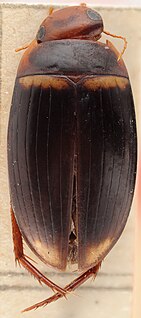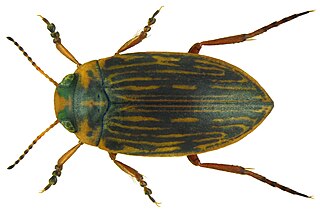
The Dytiscidae – based on the Greek dytikos (δυτικός), "able to dive" – are the predaceous diving beetles, a family of water beetles. They occur in virtually any freshwater habitat around the world, but a few species live among leaf litter. The adults of most are between 1 and 2.5 cm (0.4–1.0 in) long, though much variation is seen between species. The European Dytiscus latissimus and Brazilian Megadytes ducalis are the largest, reaching up to 4.5 cm (1.8 in) and 4.75 cm (1.9 in) respectively. In contrast, the smallest is likely the Australian Limbodessus atypicali of subterranean waters, which only is about 0.9 mm (0.035 in) long. Most are dark brown, blackish, or dark olive in color with golden highlights in some subfamilies. The larvae are commonly known as water tigers due to their voracious appetite. They have short, but sharp mandibles and immediately upon biting, they deliver digestive enzymes into prey to suck their liquefied remains. The family includes more than 4,000 described species in numerous genera.

Copelatus is a large genus of small diving beetles. There are some 470 described species in the genus, found worldwide, but they are most diverse in tropical South America, Africa and South-East Asia.

Rhantus is a genus of beetle in family Dytiscidae. There are about 100 species distributed worldwide. They often live in pools and marshy habitat types. Several species have colonized oceanic islands and become endemics.

Hydaticus is a genus of predatory water beetle belonging to the family Dytiscidae, native to the Palearctic, the Afro-tropical region, the Near East, the Nearctic and North Africa. It contains the following species:

Cybister, is a genus of beetle in family Dytiscidae native to the Old World, North America, and Australia, but has a worldwide distribution. There are approximately 80 species in the genus.
Ilybiosoma is a genus of beetles in the family Dytiscidae, containing the following species:
Platynectes is a genus of beetles in the family Dytiscidae, containing the following species:
Clypeodytes is a genus of beetles in the family Dytiscidae, containing the following species:

Hydroglyphus is a genus of beetles in the family Dytiscidae, containing the following species:
Limbodessus is a genus of beetles in the family Dytiscidae, containing the following species:
Antiporus is a genus of beetles in the family Dytiscidae, containing the following species:

Megaporus is a genus of beetles in the family Dytiscidae, containing the following species:

Nebrioporus is a genus of beetles in the family Dytiscidae, containing the following species:
Necterosoma is a genus of beetles in the family Dytiscidae, containing the following species:
Paroster is a genus of beetles in the family Dytiscidae, containing the following species:

Stictotarsus is a genus of beetles in the family Dytiscidae.
Batrachomatus is a genus of beetles in the family Dytiscidae, containing the following species:
Exocelina is a genus of beetles in the family Dytiscidae, containing the following species:

Helochares is a genus of hydrophilid beetles with over 180 species in five subgenera worldwide.
Neobidessodes is a genus of predaceous diving beetles in the family Dytiscidae. There are about 10 described species in Neobidessodes. They are found in Australasia.










